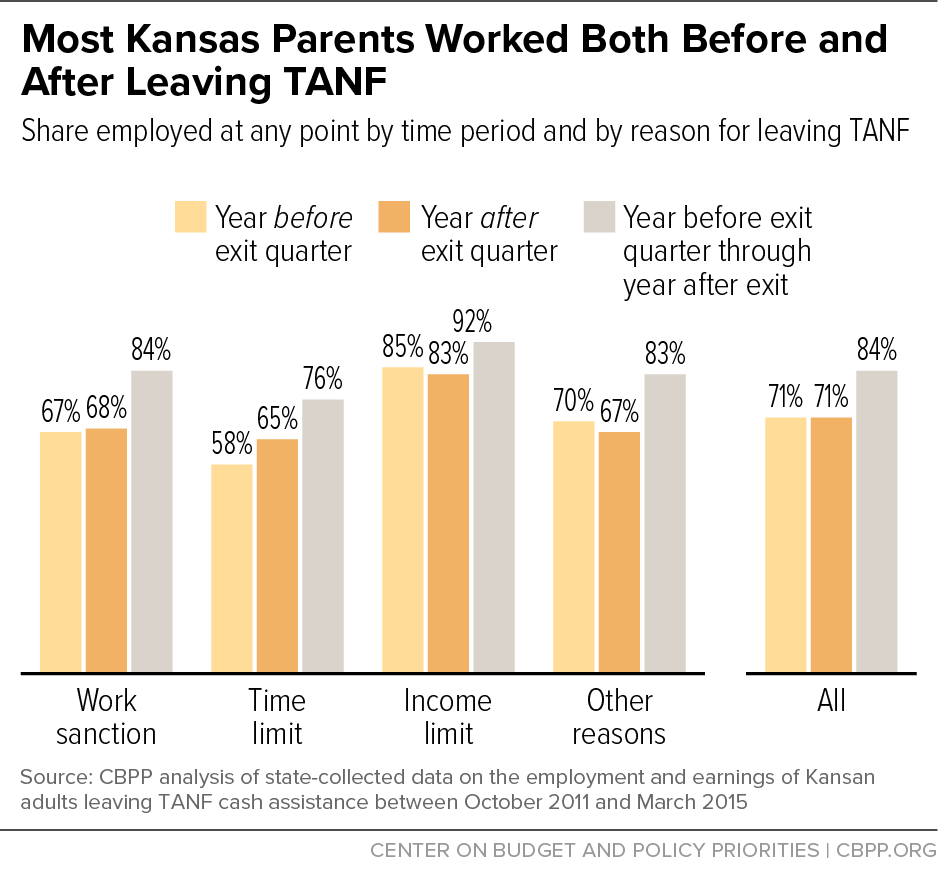BEYOND THE NUMBERS
The vast majority of Kansas families forced from the state’s Temporary Assistance for Needy Families (TANF) cash assistance program due to harsh work sanctions starting in 2011 faced extreme economic hardship after leaving, our new report shows. Most parents worked after leaving TANF — just as most parents worked at some point in the year before leaving — but most didn’t find steady jobs that paid enough to make ends meet and keep their children out of poverty.
Our findings sharply contradict a Foundation for Government Accountability (FGA) report’s assertion that the new work sanctions sparked dramatic increases in families’ work rates and earnings. As our companion report explains, the FGA report — which claims that “Kansans thrive after leaving welfare” — is fundamentally flawed, presenting findings on employment and earnings that the facts don’t support while ignoring how these families continued to struggle after leaving TANF.
Our analysis of the same state data that FGA evaluated found:
- Although some parents’ earnings rose after leaving TANF, most remained far below the federal poverty line. In the year after leaving TANF, 3 in 4 parents who left due to work sanctions had either no earnings or “deep-poverty earnings” — that is, earnings below half of the federal poverty line, or below $10,080 for a family of three in 2016. Only 8 percent had earnings above the poverty line.
- Most parents’ earnings remained extremely low four years after leaving TANF. For parents leaving TANF due to a work sanction for whom we have four years of post-TANF data, median earnings in the year after leaving were just $1,601 ($133 per month), or only 8 percent of the poverty line. That’s not even enough to cover the typical cost of natural gas and electricity for an average family in the Midwest, let alone rent, water, and other basics. By the fourth year, median earnings for this group had risen only to $2,175, or 11 percent of the poverty line, and nearly 7 in 10 still had either no earnings or deep-poverty earnings.
- Work was common, but mostly unsteady. The vast majority (84 percent) of parents leaving TANF due to a work sanction worked at some point in the year before leaving through the year after leaving. And they were roughly as likely to work in the year before leaving (67 percent) as after (68 percent). (See graph.) These findings contradict the premise underlying Kansas’ work sanctions — that it’s necessary to punish people by taking away cash assistance for an extended period to get them to work.
Parents’ work was unsteady, however. In an average quarter in the year after leaving TANF, only about half were working, which suggests that the barriers to work that many families face — such as volatile work schedules — continue affecting their job prospects.
Our findings are consistent with other studies of TANF “leavers” that show that parents continue to struggle after they leave. As proponents of punitive eligibility policies wrongly tout TANF as a model for work requirements in other programs, including Medicaid, policymakers need to understand the actual impact of harsh work sanctions on families’ work, earnings, and well-being. Rigorous experiments and research show that work requirements won’t lift people out of poverty or eliminate their need for health coverage.

